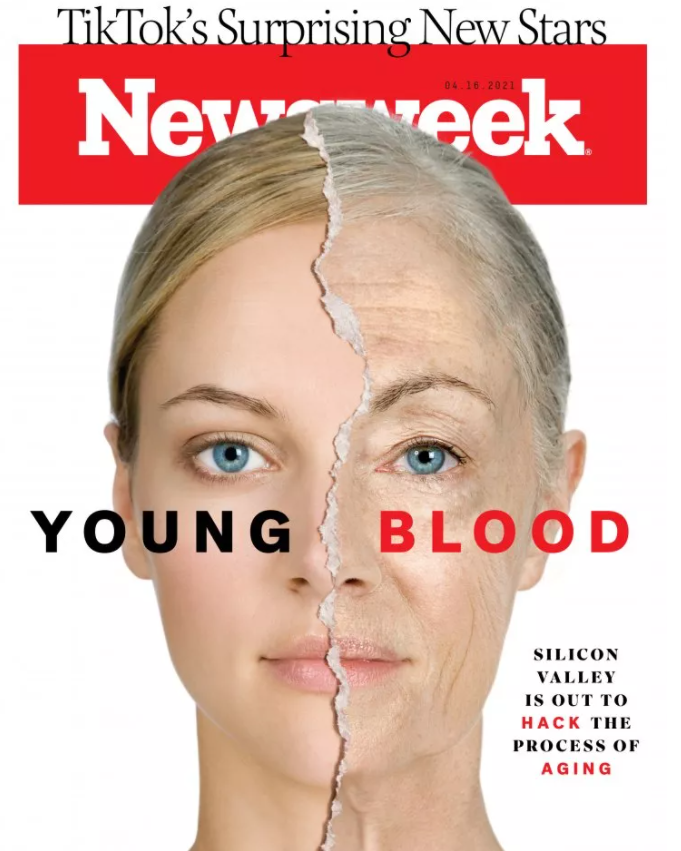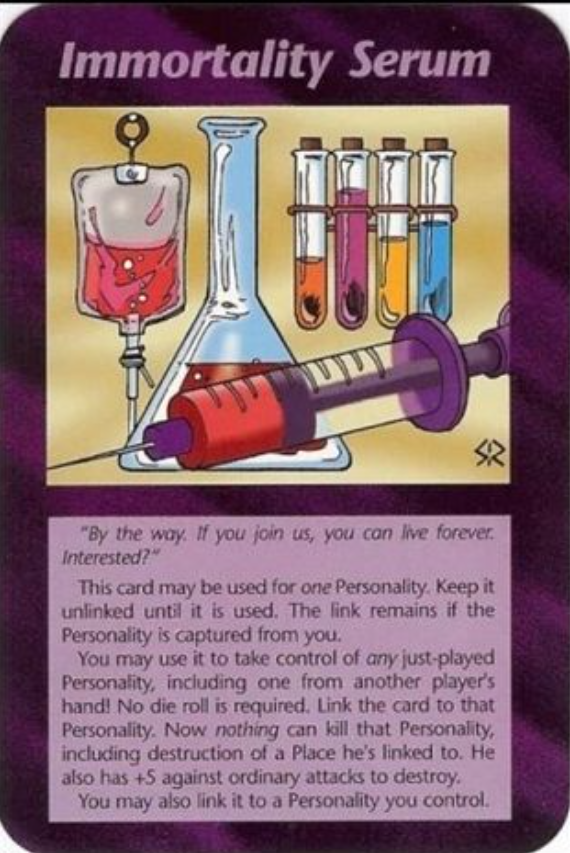AUTHOR’S NOTE: Admittedly, this report is a bit tedious and drags on, but be sure to check out my commentary at the end.
The following report is from Newsweek:
The Spanish firm Grifols helped set off a kerfuffle last year when it, along with other firms, offered nearly double the going price for blood donations for a COVID-19 treatment trial. Brigham Young University in Idaho had to threaten some enterprising students with suspension to keep them from intentionally trying to contract COVID-19. The trial failed, however, and now the Barcelona-based firm is hoping to extract something far more valuable from the plasma of young volunteers: a set of microscopic molecules that could reverse the process of aging itself.
Earlier this year, Grifols closed on a $146 million-deal to buy Alkahest, a company founded by Stanford University neuroscientist Tony Wyss-Coray, who, along with Saul Villeda, revealed in scientific papers published in 2011 and 2014 that the blood from young mice had seemingly miraculous restorative effects on the brains of elderly mice. The discovery adds to a hot area of inquiry called geroscience that “seeks to understand molecular and cellular mechanisms that make aging a major risk factor and driver of common chronic conditions and diseases of older adulthood,” according to the National Institutes of Health. In the last six years, Alkahest has identified more than 8,000 proteins in the blood that show potential promise as therapies. Its efforts and those of Grifols have resulted in at least six phase 2 trials completed or underway to treat a wide range of age-related diseases, including Alzheimer’s and Parkinson’s.
Alkahest and a growing number of other geroscience health startups signal a change in thinking about some of the most intractable diseases facing humankind. Rather than focusing solely on the etiology of individual diseases like heart disease, cancer, Alzheimer’s and arthritis—or, for that matter, COVID-19—geroscientists are trying to understand how these diseases relate to the single largest risk factor of all: human aging. Their goal is to hack the process of aging itself and, in the process, delay or stave off the onset of many of the diseases most associated with growing old.
The idea that aging and illness go hand and hand is, of course, nothing new. What’s new is the newfound confidence of scientists that “aging” can be measured, reverse-engineered and controlled.
[Until recently] people working on diseases did not think that aging was modifiable. That is actually what many medical books say: The main risk factor for cardiovascular disease is aging, but we cannot change aging so let’s talk about cholesterol and obesity. For Alzheimer’s, aging is the main risk factor—but let’s talk about the buildup in the brain of beta-amyloid proteins. Now that is beginning to change.Felipe Sierra, who recently retired as director of the Division of Aging Biology at the National Institute on Aging, a part of the NIH.
The result is a flood of investment money, an explosion of research into what precisely goes wrong in our bodies as we get old and the promise of clinical results down the road.
In the months before the pandemic, investors ponied up billions of dollars to fund biotechs aimed at commercializing the new science. Some biotech firms are developing drugs and infusions designed to clean up zombie-like cells and metabolic junk that accumulate with age. Others hope to infuse new vigor into flagging cellular components, such as stem cells, or spur the body into beneficial actions by adding obscure hormones or proteins, that decrease as we get older. The NIA, under its director, Richard Hodes, recently announced plans to spend about $100 million over the next five years on basic research aimed at understanding “cellular senescence.”
You have no idea how many people are interested to investing money in longevity. There are billions of dollars.
Nir Barzilai, the founding director of the Institute for Aging Research at Albert Einstein College of Medicine of Yeshiva University, and the founder of a company aimed at mitochondrial health.
Although the vast majority of these efforts remain in preclinical development, several have recently entered FDA trials and could potentially hit the market in a few years. Some are already appearing on the gray market, raising concerns that hucksters are peddling anti-aging snake oil. Others, meanwhile, worry what might happen if these drugs actually do deliver on their promise: Will poor young people be coerced into selling their blood to elderly billionaires? Will magical anti-aging pills become the province of the Park Avenue and Hollywood rich, like facelifts, hair plugs and botox injections? Will the rest of us senile peasants be forced to watch them age backwards as we are left to wither and die?
Hacking Old Age
Getting old usually doesn’t end well. Despite massive gains in human life expectancy—over the last 150 years, it has almost doubled in many developed nations, though it dipped in the past year due to the pandemic—we still haven’t found a way to halt the relentless toll time takes on our bodies.
When we grow old, our immune systems begin to break down, creating a state of low-level inflammation that suppresses cellular regeneration and leads to those aches and pains. We may be living longer, but we are hurting. As our mitochondria cease to effectively produce energy for our cells, we spend many of those hard-won extra years taking afternoon naps. As our stem cells grow lethargic and quiescent, our muscle mass shrinks and our bones become increasingly fragile. In short, our bodies fall apart.
The first hint that hacking the biology of aging might be possible came, improbably enough, from a series of laboratory experiments on a lowly species of roundworm. In the late 1980s and early 1990s, studies of identical twins had already shown that about 30 percent of longevity in humans could be attributed to genetics. But most scientists believed the process of aging was far too complex a phenomenon to modulate simply by tweaking a couple genes or taking a pill.
Then in 1993, Cynthia Kenyon, a biologist at the University of California in San Francisco, doubled the lifespan of a worm from three weeks to six by mutating a single gene. The work suggested the possibility of drugs that could increase longevity without targeting specific diseases. It suggested that the process of aging itself might be manipulated.
At the time, a fringe group of longevity enthusiasts were, unknowingly, already trying to do what Kenyon did in roundworms through the practice of calorie restriction. This idea took off when gerontologist Roy Walford of UC Los Angeles doubled the lifespan of lab mice by restricting their caloric intake and then became a vocal advocate for the practice in humans. He penned a series of best-selling books in the 1980s and adopted a 1,600-calorie-a-day diet for the last 30 years of his life. Today, his emaciated acolytes can still be spotted at longevity conferences, meticulously measuring out their food during lunch breaks.
Emerging science now explains why there may be something to this method of bio-hacking. In humans, insulin is the hormonal signal that cues our cells to absorb sugar and convert it to energy. Along with a closely related hormone called Insulin like-Growth Factor 1 (IGF1), insulin affects a large number of other cellular processes, including the rate of cellular division, which many believe is directly related to aging. When the insulin and IGF1 in humans or analogous compounds in worms are dialed down—because we are starving, or the genes have been tweaked—a host of cellular repair mechanisms that are normally on standby kick into high-gear.
The adaptation makes sense from the perspective of evolution. Prehistoric times consisted of long periods of scarcity punctuated by precious windows of abundance. Since there was no telling how long the good times would last, our ancestors evolved the ability to grow and build fat and muscle as quickly as possible. A feast triggered the body to release insulin and IGF1, which allowed our cells to begin absorbing glucose and spurred them to pour energy into cellular reproduction and regeneration for as long as our insulin levels remain high.
When calories were no longer easy to come by, our bodies adjusted by lowering insulin and IGF1 levels—a cue for our cells to slow regeneration and reproduction, and instead divert energy into cellular processes most likely to facilitate our survival through cold, lean times. The human body protects cells it already has: it produces more enzymes to ensure proteins don’t misfold, it ramps up the machinery designed to repair broken DNA and it breaks down cellular debris and defective cells it might otherwise ignore, scavenging for parts it can use to feed its healthier cells through the lean days. In the process, it cleans up cellular garbage that, particularly as we grow older, likely promotes low-level inflammation.
Currently there is no FDA-approved indication for drugs that target the process of aging itself. To win approval, drugs must target a specific disease. It’s no coincidence that some gerontologists have chosen the popular diabetes drug metformin to serve as the “template” for a new class of FDA-approved anti-aging drugs. It works by influencing the body’s sensitivity to insulin and can have an effect on the pace of metabolism and energy expenditure. If studies now underway confirm its efficacy and it wins approval, it would create an entirely new regulatory category of drugs that, rather than treating specific diseases, will work to prevent our bodies from deteriorating further once we have already developed one.
Aging drives disease. That’s our point. If we stop aging, it stops driving the diseases.
Nir Barzilai
A whole host of other potential anti-aging-drugs might not be far behind. Molecular biologists discovered a second important way to manipulate the aging process in the early 2000s by breeding strains of baker’s yeast, fruit flies and worms to live longer. They sequenced the genomes of the hardiest strains and then worked backward to identify the specific genetic variants that seemed be associated with increased longevity. That led them to mTOR, a genetic variant that serves as the target of an anti-aging drug called rapamycin, which is now undergoing clinical trials. Among these scientific efforts is a massive longitudinal study of canine aging at the University of Washington, which has enrolled 30,000 dogs and plans to select 500 lucky pooches to participate in a rapamycin trial.
The hunt for other “control knobs” that might be targeted with drugs continues at research institutions around the world. A third approach would increase the production an enzyme called AMP-Kinase, which modulates cellular processes like growth and metabolism, based on the level of energy available for consumption. It, too, has emerged in recent years as another promising target, along with many other molecules, hormones and proteins that appear to decline with age and that play a key role in cellular repair, regeneration, protection and efficient function.
Vera Gorbunova, co-director of the Rochester Aging Research Center at the University of Rochester, and her colleagues compared 18 rodent species, including, beavers, hamsters and mice, sorted them by longevity, and looked for interesting patterns. Significantly, they found that “more robust” repair of broken DNA, the molecular-level cellular blueprints found in every one of our cells, seems to coevolve with longevity. In other words, species that live longer have a more robust ability to fix the kind of problems that inevitably occur with age. The research was recently published in the journal Cell.
There was a very strong correlation to how long different species live and how well they repaired DNA breaks. We also look at why it’s better. We found a protein that is very important in DNA repair and it is more active in long-lived species.
Vera Gorbunova
Gorbunova has done some of her most exciting work on an obscure superstar in the longevity field known as the naked mole rat, a furless, wrinkled rodent with a pair of beaver-like incisors that lives in tunnels in East Africa. The rat, sometimes referred to by its cuddly nickname, “Sand Puppy,” has an unusually long-life expectancy—30 years, 10 times longer than its close cousin, the North American field mouse, which rarely makes it past three.
Gorbunova traces much of the hardiness of the mole rats to an abundance of hyaluronic acid, a major component of skin that is involved in tissue regeneration. Although mice and humans also have hyaluronic acid, the tissues of naked mole rats are “saturated with it,” says Gorbunova. In addition to having strong antioxidant properties, and others that seem to attenuate the destructive consequences of the chronic, widespread inflammation that often accumulates with age, the abundance of hyaluronan also seems to prevent the growth of malignant cancer cells.
Hyaluronan is a very nice story because we can see the possibility of translating it to humans. We have it, but we don’t have a lot of it, so I think there is room for improvement. We can find ways to increase our own levels of hyaluronan.
Vera Gorbunova
To Gorbunova, the differences between the mouse and naked mole rat are easily explained by evolution—their respective adaptations are geared toward increasing their chances of reproductive success.
For a mouse, the best strategy to have more progeny is to be very, very prolific very quickly because then somebody’s going to eat it, and it just doesn’t have a chance to live longer. The naked mole rat lives underground and has very few predators. And they breed until very late in life. So they would evolve the mechanism to allow them to live longer and to breathe as long as possible just because they can. No one is there to eat them. And the longer they live the more progeny they have.
The same logic applies to humans—and it also explains why our bodies fall apart. Diseases of aging, many gerontologists now argue, are the natural consequence of the advances in modern lifespan, which now extends decades past reproductive age, and thus has not been subject to the same exquisitely efficient evolutionary sculpting that might increase our odds of surviving them.
If you put this work in an evolutionary perspective, we were not supposed to live that long. Aging is an invention of mankind. No animal species has successfully cheated its own body—cheated nature—except mankind. Elephants may live for 100 years but they lived for 100 years a million years ago. Humans have outsmarted their own body.
Gerard Karsenty, who chairs the Department of Genetics and Development at Columbia University Medical Center.
But what does any of this have to do with Wyss-Coray and Villeda’s young blood?
Regeneration
Saul Villeda now runs a lab at UCSF on a hill that Over-looks San Francisco’s famed Haight-Ashbury. Winding stairs lead to a fluorescent-lit basement hallway and a cramped suite of rooms stacked wall-to-wall with mouse cages. There is something unusual about many of the mice in the room. They are ambulating through their cages, with two heads, two sets of legs and double-wide bodies.
The doublewide mice are products of a macabre procedure known as “parabiosis,” a technique Villeda mastered as a graduate student in the lab of Wyss-Coray for the improbable experiment that led to the founding of Alkahest and the clinical blood trials aimed at treating aging. The procedure, pioneered in the 19th century by the French scientist Paul Bert, merges the circulatory systems of two rodents by cutting open their bodies and sewing their wounds together, so that their bodies fuse as they heal.
To learn it, Villeda had an expert teacher: Thomas Rando, a neurologist who studies longevity and occupies the office next door to Wyss-Coray. Rando first got the idea to revive the obscure technique back in the early 2000s. He had come to believe that one of the reasons our bodies lose their regenerative powers as we grow older is because our stem cells stop receiving the molecular-level signals needed to activate them. Rando did not know what those signals might be. But he knew where to find them—the blood of younger mice. Enter parabiosis.
To test out his hypothesis, Rando conjoined elderly mice with younger rodents so that they shared the same circulatory system, then tested their ability to heal small wounds. The results were dramatic. Elderly mice were able to repair small tears in their muscles far faster than their peers not conjoined to younger mice. The younger mice, on the other hand, healed far slower than they normally would.
The results were exhilarating. They suggested that stem cells could be revitalized simply by reintroducing back into the blood stream the molecules, present in young blood, that could turn them on. The next step was finding the specific youth-promoting factors in the blood responsible for the change. But that would not be easy.
It’s as big a fishing expedition as you can possibly imagine.
Rando warned at the time, noting the thousands of proteins, lipids, sugars and other small molecules in the blood serum.
Watching this unfold from next door, Wyss-Coray, who studied Alzheimer’s Disease, and then-graduate student Villeda were dubious that they could induce a similar rejuvenation in the brain. Whatever it was in the young blood that spurred the regeneration, it seemed unlikely it would be able to pass the blood-brain barrier, the semipermeable border that keeps circulating blood, and much of the cargo it carries, from entering the central nervous system.
But we did it anyways, because I was a graduate student at the time, and Tony will always support crazy ideas.
Saul Villeda
After conjoining elderly and young mice, Villeda sacrificed the elderly mice, cut their brains into tiny slices, and stained them with a special dye that bound to baby neurons. Then he counted up the number of new neurons and compared them to normal levels of neuronal growth in similarly aged mice. The results, when he published them in 2014, shocked the scientific world. The infusion of new blood led to a threefold increase in the number of new nerve cells generated in the brains of the elderly mice. But that was not the only revelation. He had already shown that the young members of the conjoined old-young mouse pairs generated far fewer new nerve cells than young mice left to roam free, untethered to their elderly cousins. And while the old mice grew more energetic, the younger mice suddenly behaved as if they were middle-aged.
Since parabiosis is not an option for human patients, Villeda and Wyss-Coray tried to pull off the same trick with a simple infusion of blood plasma. There, too, the results were better than they expected. On spatial-navigation tasks, such as finding an underwater platform to rest on in a water-filled chamber, the young mice that had received injections of “old blood” performed far worse than a group that got injections of plasma from younger mice. Once infused with the blood of young mice, the old-blood mice, meanwhile, were able to locate the platform as easily as their younger brethren.
The results generated worldwide headlines. And soon Wyss-Coray and his protégé Villeda began receiving many bizarre and at times macabre emails. One chilling missive came from a man who offered to provide all the blood Wyss-Coray might need for such an experiment—he claimed he could obtain it from human children of any age. There was also a flood of heartfelt pleas from Alzheimer’s patients and their loved ones inquiring about human trials, desperate to stave off the ruthless march of the incurable, degenerative disease.
The query that changed Wyss-Coray’s life came from the family of recently deceased Chinese billionaire Chen Din-hwa, also known as Hong Kong’s “King of Cotton Yarn,” for the yarn-supply business he established in 1949.
On his death bed, suffering from advanced Alzheimer’s disease, Din-hwa, 89, received blood plasma infusions for an unrelated medical condition. In the hours that followed, his grandson Vincent would later tell Wyss-Coray, the old man grew surprisingly alert and coherent, allowing his loved ones a few precious final moments of connection. The young blood seemed to have had a remarkably restorative effect on the old man, just as it had for Wyss-Coray’s mice.
After Din-hwa’s death in 2012, Vincent, a molecular biologist from UC Berkeley, tried to explain the bizarre phenomenon. He eventually found Wyss-Coray and Villeda’s first paper on the mice.
The word got to Wyss-Coray via a mutual acquaintance in the biotech industry. “He said, ‘Tony, there’s this rich person in Hong Kong’,” Wyss-Coray recalls. “‘He wants to start a company. Are you interested?'”
Vincent and Wyss-Coray formed Alkahest, a San Carlos-based biotech that has raised upward of $150 million from the Din-hwa family company—the Nan-Fung Group—Stanford University, the Michael J. Fox foundation and Grifols, the mammoth Spanish Blood Plasma company that would eventually buy everyone else out.
The real work of finding out precisely what it was in the blood that caused this remarkable transformation was only just beginning.
Aging Chemistry
In the years since the initial mice experiments, Villeda, Wyss-Coray and a number of independent investigators have identified an array of proteins that seem to have promising restorative effects—or, in the blood of elderly mice, detrimental effects. Both kinds could prove useful as potential drug targets. If DNA is the body’s blueprint, proteins are its building materials. These essential molecules, composed of amino acids, are not only the fundamental material from which we construct bone, skin, muscle and brain cells. They are also the units used to make hormones and other molecular-level signaling agents that carry messages from one part of the body to another. With age, it seems, many of the proteins we need to function efficiently decline, while proteins that aren’t good for us accumulate in inconvenient places and gum up the works.
Villeda has isolated a molecule present in mice that blocks the regeneration of brain cells and promotes cognitive decline. The molecule seems to be connected to the gradual, age-related breakdown of the immune system, and when injected into the blood of younger mice, these proinflammatory molecules can impair cognition. And in May 2019, Wyss-Coray demonstrated it was possible to block the activity of another protein that accumulates with age, triggering a powerful restorative effect and vastly improving the performance of elderly mice on tests that measure memory and cognitive abilities.
Conversely, Villeda recently discovered a protein that promotes learning and memory in young mice. Columbia’s Karsenty has identified a powerful hormone that prevents depression and enhances memory, among other things, but which seems to decline with age. In humans, the hormone drops precipitously after the age of 50.
Whether Alkahest’s blood fractions or any other drug will ever make it out of clinical trials remains uncertain. But it does seem likely that the first of a new class of drugs will win approval before too long.
In 2019, Alkahest presented preliminary results at a medical conference from phase II clinical trials, which are aimed at establishing initial dosing data but can also reveal insights about how and whether a drug is working in a small population of patients. The results suggested blood-plasma infusions slowed cognitive and functional decline in patients suffering from mild-to-moderate Alzheimer’s Disease. Mice studies suggest the blood promotes the growth of new brain cells and reduces neuroinflammation. The company also has trials in various phases of development to treat Parkinson’s, dementia and post-operative recovery, and has isolated a variety of molecules present in old blood that it plans to modulate with drugs.
In addition to Alkahest’s blood fraction trials, a new class of “anti-aging” drugs called “senolytics,” which aim to clear out “zombie-like” senescent cells that accumulate with age, have entered trials. Senescent cells are those that have stopped dividing and secrete proinflammatory factors that suppress the normal mechanisms of cellular repair and create a toxic environment for their neighbors. The most prominent company to market that mechanism, Unity Biotech, raised more than $220 million and went public on NASDAQ in 2018. Although its drug for osteoarthritis of the knee was halted after disappointing Phase 2 trials, another senolytic drug aimed at treating age-related vision decline is currently underway; results from Phase 1 trials are expected by July.
Many other drugs are in development. In the days before COVID-19 struck, scientists at 14 research institutions across the nation were recruiting 3,000 individuals between the ages of 65-79 to participate in a six-year $50 million study known as the TAME trial (for Targeting Aging with the diabetes drug metformin.) That study aims to demonstrate that metformin can delay the onset of age-related chronic diseases, such as heart disease, cancer and dementia, in those already afflicted. Barzilai, who is coordinating the study, says he and his colleagues are launching the effort not “so we can have everybody on metformin but because we need the clinical indication approved.”
Of all the candidates, metformin has perhaps the most established track record in humans—at least in diabetics.
The cool thing about metformin is we have had it for 60 years. It’s one of the safest drugs, one of the cheapest drugs.
Nir Barzilai
The Dark Side of Long Life
Despite the excitement, it’s too early to celebrate. The data on whether metformin works in healthy people is not definitive. And senolytics and blood plasma fractions have yet to be tested in a large population of patients.
That probably won’t stop people from capitalizing on the buzz to exploit the most vunlerable patients. Some cancer patients desperate for a cure are known to head down to Mexico or obscure tropical islands for dangerous, unproven stem cell treatments.
In 2016, a former Stanford Medical School student named Jesse Karmazin, opened up Ambrosia, a clinic in Monterey, California, offering to infuse clients with the blood of donors between the ages of 16 and 25 for $8000 a liter. In December 2018, HuffPost published an investigation claiming that the only patient who spoke publicly about Ambrosia’s transfusions—treatments he hoped would help him live healthier into old age—died at 65 after going into cardiac arrest.
The FDA issued an advisory two months later warning elderly consumers that these transfusions “should not be assumed to be safe or effective” and consumers should be strongly discouraged from “pursuing this therapy outside of clinical trials under appropriate institutional review board and regulatory oversight.”
Business Insider reported in August 2019 that Karmazin said he was shutting Ambrosia down. By November, he’d hung a new shingle, Ivy Plasma, offering “off-label” treatments with young blood and raising renewed alarms from public health officials and scientists. That’s a “perfect example” of an intervention that has been shown to work in mice but has yet to be proven in humans, says Matt Kaeberlein, a Professor of Pathology at the University of Washington in Seattle.
Kaberlein, who has begun what he hopes will grow into a 100,000-strong longitudinal study on canine aging while also running a large study of rapamycin’s effectiveness in extending the lives of elderly dogs, says there is “a ton of money” flowing into the field and “a number of promising trials and interventions.” But none has yet to clear the high bar set by the FDA: a large phase-3 clinical trial that shows evidence that patients improve significantly and that side effects do not outweigh the potential benefits. When that will happen is difficult to say: the coronavirus pandemic has disrupted trials and diverted attention to COVID-19.
Despite the excitement, it’s too early to celebrate. The data on whether metformin works in healthy people is not definitive. And senolytics and blood plasma fractions have yet to be tested in a large population of patients.
That probably won’t stop people from capitalizing on the buzz to exploit the most vunlerable patients. Some cancer patients desperate for a cure are known to head down to Mexico or obscure tropical islands for dangerous, unproven stem cell treatments.
In 2016, a former Stanford Medical School student named Jesse Karmazin, opened up Ambrosia, a clinic in Monterey, California, offering to infuse clients with the blood of donors between the ages of 16 and 25 for $8000 a liter. In December 2018, HuffPost published an investigation claiming that the only patient who spoke publicly about Ambrosia’s transfusions—treatments he hoped would help him live healthier into old age—died at 65 after going into cardiac arrest.
The FDA issued an advisory two months later warning elderly consumers that these transfusions “should not be assumed to be safe or effective” and consumers should be strongly discouraged from “pursuing this therapy outside of clinical trials under appropriate institutional review board and regulatory oversight.”
Business Insider reported in August 2019 that Karmazin said he was shutting Ambrosia down. By November, he’d hung a new shingle, Ivy Plasma, offering “off-label” treatments with young blood and raising renewed alarms from public health officials and scientists. That’s a “perfect example” of an intervention that has been shown to work in mice but has yet to be proven in humans, says Matt Kaeberlein, a Professor of Pathology at the University of Washington in Seattle.
Kaberlein, who has begun what he hopes will grow into a 100,000-strong longitudinal study on canine aging while also running a large study of rapamycin’s effectiveness in extending the lives of elderly dogs, says there is “a ton of money” flowing into the field and “a number of promising trials and interventions.” But none has yet to clear the high bar set by the FDA: a large phase-3 clinical trial that shows evidence that patients improve significantly and that side effects do not outweigh the potential benefits. When that will happen is difficult to say: the coronavirus pandemic has disrupted trials and diverted attention to COVID-19.
The idea that only old, rich people can afford young blood is just uncomfortable.
Nir Barzilai
Most geroscientists advise against self-treatments. It would be unwise, they say, to start popping rapamycin, metformin and other largely unproven supplements on the market that promise big effects. For now, the only proven anti-aging cures remain what they have always been: regular exercise, a good night’s sleep and a healthy diet.
Correction (4/7/21, 9:39 pm EDT): The first sentence was modified to make it clear that Grifols was not the only firm to offer higher than typical prices for blood donations for COVID-19 treatment trials. Also, Tony Wyss-Coray is a neuroscientist, not a neurologist as originally reported.
Correction: (4/8/21, 1:10 pm EDT): Geroscience is a general inquiry into what makes aging a risk factor and is not specific to the blood, as originally reported.

AUTHOR COMMENTARY
If you skimmed some of this report, don’t feel bad: I kind of did too.
But I am mentioning this report, because not only is it disgusting and vile to hear what these mad witchdoctors and “scientists” are doing, but this is the stuff Alex Jones and Qanon have been harping on for quite some time.

To clarify something about Qanon, and Jones, that I may not have been clear about enough before: a lot of what they say is true. One of the major and “far-out” claims made by Q was that the Democrats (and all those that hate Trump) are part of this international pedophile cabal and child-sacrificing ring where they harvest children’s organs and blood. One of these compounds extracted from the blood is known as “Adrenochrome.”
To be clear, I have believed this type of stuff goes for some time now, but that does not make me an “anon” that worships Trump. The Old Testament is full of child sacrifice, cannibalism, sex rituals, bestiality, and many other abominations – so it is not much of a stretch for me to think it is happening now.
[24] Behold, here is my daughter a maiden, and his concubine; them I will bring out now, and humble ye them, and do with them what seemeth good unto you: but unto this man do not so vile a thing. [25] But the men would not hearken to him: so the man took his concubine, and brought her forth unto them; and they knew her, and abused her all the night until the morning: and when the day began to spring, they let her go. [26] Then came the woman in the dawning of the day, and fell down at the door of the man’s house where her lord was, till it was light. [27] And her lord rose up in the morning, and opened the doors of the house, and went out to go his way: and, behold, the woman his concubine was fallen down at the door of the house, and her hands were upon the threshold. [28] And he said unto her, Up, and let us be going. But none answered. Then the man took her up upon an ass, and the man rose up, and gat him unto his place. [29] And when he was come into his house, he took a knife, and laid hold on his concubine, and divided her, together with her bones, into twelve pieces, and sent her into all the coasts of Israel. [30] And it was so, that all that saw it said, There was no such deed done nor seen from the day that the children of Israel came up out of the land of Egypt unto this day: consider of it, take advice, and speak your minds.Judges 19:24-30
The hands of the pitiful women have sodden their own children: they were their meat in the destruction of the daughter of my people.
Lamentations 4:10
[2] Twenty years old was Ahaz when he began to reign, and reigned sixteen years in Jerusalem, and did not that which was right in the sight of the LORD his God, like David his father. [3] But he walked in the way of the kings of Israel, yea, and made his son to pass through the fire, according to the abominations of the heathen, whom the LORD cast out from before the children of Israel. [4] And he sacrificed and burnt incense in the high places, and on the hills, and under every green tree.2 Kings 16:2-4
Additionally, there have been subtle “nods” to this in the media before Q became so mainstream.

Since the media has decided to quietly release this story now, it will give the illusion of affirmation and “credibility” to the claims of Qanon and Alex Jones again, restrengthing those movements and counter-intelligence operations.
The WinePress needs your support! If God has laid it on your heart to want to contribute, please prayerfully consider donating to this ministry. If you cannot gift a monetary donation, then please donate your fervent prayers to keep this ministry going! Thank you and may God bless you.







